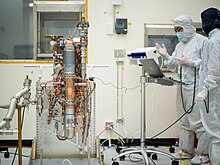 | |
| Operator | NASA |
|---|---|
| Manufacturer | Southwest Research Institute |
| Instrument type | mass spectrometer |
| Function | chemical analyzer |
| Mission duration | Cruise: 3-6 years Science phase: ≥ 3 years |
| Properties | |
| Mass | 8 kg |
| Dimensions | 40 cm |
| Resolution | 1 ppt |
| Host spacecraft | |
| Spacecraft | Europa Clipper |
| Operator | NASA |
| Launch date | October 14, 2024, 16:06:00 UTC (12:06 p.m. EDT) |
| Rocket | SLS |
| Launch site | Kennedy Space Center |
The MAss Spectrometer for Planetary EXploration (MASPEX) is a time-of-flight mass spectrometer capable of high-resolution and high-sensitivity that allows the determination of a wide variety of chemical compounds in complex mixtures. This instrument will fly on board the planned Europa Clipper orbiter to explore Jupiter's moon Europa. This astrobiology mission will analyse the composition of Europa's surface while in orbit, and will directly assess its internal ocean habitability by flying through Europa's tenuous atmosphere.
On 27 May 2016 it was announced that MASPEX was selected to fly on the mission.[1] The instrument has also been proposed to fly on three Discovery program missions: Enceladus Life Finder (ELF), comet Hartley 2 (PRIME), and to the main belt comet Read (Proteus).[2] It also has applications for probes, landers, and sample return missions. The original Principal Investigator was Jack Waite, and the Technical Lead is Tim Brockwell, from the Southwest Research Institute. In 2020 NASA announced that Jim Burch of Southwest Research Institute would become the Principal Investigator and that some instrument capabilities might be reduced due to technical and financial limitations.
- ^ "Two Southwest Research Institute instruments selected for NASA Europa mission". SWRI. 27 May 2016. Retrieved 2017-10-24.
- ^ Cite error: The named reference
Brockwell 2016was invoked but never defined (see the help page).